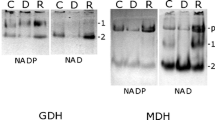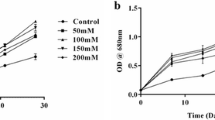Abstract
The vitamin content in four Australian microalgae, a Nannochloropsis-like sp., Pavlova pinguis, Stichococcus sp. and Tetraselmis sp., were examined. These were grown under a 12:12 h light:dark regimen (100 μmol photon m−2s−1) and harvested during late-logarithmic phase. Typically, the content showed a two- to three fold range between the species. When expressed on a dry weight basis, the content of ascorbate ranged from 1.3 to 3.0 mg g−1, β-carotene from 0.37 to 1.05 mg g−1, α-tocopherol from 0.07 to 0.29 mg g−1, thiamine from 29 to 109 μg g−1, riboflavin from 25 to 50 μg g−1, total folates from 17 to 24 μg g−1, pyridoxine from 3.6 to 17 μg g−1, cobalamin from 1.70 to 1.95 μg g−1 and biotin from 1.1 to 1.9 μg g−1. Retinol was detected only in Tetraselmis sp. (2.2 μg g−1); any vitamins D2 or D3 were below the detection limit (≤0.45 μg g−1). Nannochloropsis sp. was also grown under a 24:0 h light:dark light cycle and harvested at stationary phase. The content of most vitamins in Nannochloropsis sp. cultures differed significantly, and the degree of variation was similar to that observed between the four species grown under 12:12 h light:dark regimen (100 μmol photon m−2s−1) and harvested during late-logarithmic phase. Thiamine content was also examined in six non-Australian strains commonly used in aquaculture, Chaetoceros muelleri, Thalassiosira pseudonana, Nannochloris atomus, Nannochloropsis oculata, Isochrysis sp. (T.ISO) and Pavlova lutheri. Values (average 61 μg g−1; range 40 to 82) were similar to those in the Australian strains (average 61 μg g−1; range 29 to 109) and increased during stationary phase (average 94 μg g−1; 38 to 131). Comparison of the data with the known nutritional requirements for marine fish species and prawns suggests that the microalgae should provide excess or adequate levels of the vitamins for aquaculture food chains. The data may be used to guide the content of vitamins included in micro-diets developed as replacements for live diets.
Similar content being viewed by others
References
AOAC (1990) Cobalamin (vitamin B12 activity) in vitamin preparations. In AOAC Official Methods of Analysis, 1990, pp. 1082–1083.
Bayanova YI, Trubachev IN (1981) Comparative evaluation of the vitamin composition of some unicellular algae and higher plants grown under artificial conditions. Appl. Biochem. Microbiol. 17: 292–298.
Bergaentzle M, Arella F, Bourguignon JB, Hasselman C (1995) Determination of vitamin B6 in foods by HPLC – a collaborative study. Food Chem. 52, 81–86.
Bonjour J-P (1984) Biotin. In Machlin L (ed.), Handbook of Vitamins: Nutritional, Biochemical and Clinical Aspects, Marcel Decker, Inc. New York., pp. 403–435.
Brown MR, Farmer CA (1994) Riboflavin content of six species of microalgae used in mariculture. J. appl. Phycol. 6: 61–65.
Brown MR, Miller KA (1992) The ascorbic acid content of eleven species of microalgae used in mariculture. J. appl. Phycol. 4: 205–215.
Brown MR, Jeffrey SW, Garland CD (1989) Nutritional aspects of microalgae used in mariculture: a literature review. CSIRO Mar. Lab. Rep., No. 205, 44 pp.
Brown MR, Skabo S, Wilkinson B (1998) The enrichment and retention of ascorbic acid in rotifers fed on microalgal diets. Aquaculture Nutrition 4: 151–156.
Brubacher G, Muller-Mulot W, Southgate DAT (1985) Vitamin A (retinol and retinyl esters) in food: HPLC methods. In Brubacher G, Muller-Mulot W, Southgate DAT (eds), Methods for the Determination of Vitamins in Foods. Elsevier Applied Science Publishers Ltd., Crown House, Essex, pp. 23–32.
Castell JD, Conklin DE, Craigie JS, Lall SP, Norman-Boudreau K (1986) Aquaculture nutrition. In Bilo M, Rosenthal H, Sindermann CJ (eds), Realism in Aquaculture: Achievements, Constraints, Perspectives, Proceedings of the World Conference on Aquaculture, Venice, Italy, 21–25 September, 1981. European Aquaculture Society, Bredene, Belgium, pp. 251–308.
Chu F-LE, Webb KL, Hepworth DA, Casey BB (1987) Metamorphosis of larvae of Crassostrea virginica fed microencapsulated diets. Aquaculture 64: 185–197.
Conklin DE (1997) Vitamins. In Crustacean Nutrition, Advances in World Aquaculture, Vol. 6, D'Abramo LR, Conkin DE, Akiyama DM (eds), World Aquaculture Society, 1997, pp. 123–149.
Dawson KR, Unklesbay NF, Hedrick HB (1988) HPLC Determination of riboflavin, niacin and thiamin in beef, pork, and lamb after alternate heat processing methods. J. Agric. Food Chem. 36: 1176–1179.
De Roeck-Holtzhauer Y, Quere I, Claire C (1991) Vitamin analysis of five planktonic microalgae and one macroalga. J. appl. Phycol. 3: 259–264.
Enright CT, Newkirk GF, Craigie JS, Castell JD (1986) Evaluation of phytoplankton as diets for juvenile Ostrea edulis L. J. exp. mar. Biol. Ecol. 96: 1–13.
Fellman JK, Artz WE, Tassinari PD, Cole CL, Augustin J (1982) Simultaneous determination of thiamin and riboflavin in selected foods by high-performance liquid chromatography. J. Food Sci. 47: 2048–2067.
Guillard RRL, Ryther JH (1962) Studies on marine planktonic diatoms. I. Cyclotella nana Hustedt, and Detonula confervacea (Cleve) Gran. Can. J. Microbiol. 8: 229–239.
Hapette AM, Poulet SA (1990) Application of high-performance liquid chromatography to the determination of ascorbic acid in marine plankton. J. Liquid Chromatogr. 13: 357–370.
Hensel A, Witthoft C, Bitcsch I (1995) HPLC analysis of food folates (4 EU MAT folate program). In Schubert R, Flachowsky G, Bitsch R (eds), Vitam. Zusatzst. Ernaehr. Mensch. Tier, Symp., 5th, Institut für Ernährung und Umwelt, Jena Germany, pp. 296–299.
Jones DA, Kamarudin MS, Le Vay L (1993) The potential for replacements of live feeds in larval culture. J.World Aquacult. Soc. 24:199–210.
Jones G, Seamark DA, Trafford DJH, Makin HLJ (1985) Vitamin D: Cholecalciferol, ergocalciferol, and hydroxylated metabolites. In De Leenheer AP, Lambert WE, De Ruyter MGM (eds), Modern chromatographic analysis of the vitamins, Marcel Decker Inc., New York, pp. 129–200.
Langdon CJ, Bolton ET (1984) A microparticulate diet for a suspension-feeding bivalve mollusc, Crassostrea virginica (Gmelin). J. exp. mar. Biol. Ecol. 82: 239–258.
Langdon CJ, Waldock MJ (1981) The effect of algal and artificial diets on the growth and fatty acid composition of Crassostrea gigas spat. J. Mar. Biol. Ass. U.K. 61: 4531–448.
Maruyama I, Hirayama K (1993) The culture of the rotifer Brachionus plicatilis with Chlorella vulgaris containing vitamin B12 in its cells. J. World Aquaculture Society 24: 194–198.
Merchie G, Lavens P, Radull J, Nelis H, De Leenheer A, Sorgeloos P (1995) Evaluation of vitamin C-enriched Artemia nauplii for larvae of the giant freshwater prawn. Aquacult. Int. 3: 355–363.
Nelis HJ, De Bevere VORC, De Leenheer AP (1985) Vitamin E: Tocopherols and tocotrienols. In De Leenheer AP, Lambert WE, De Ruyter MGM (eds), Modern Chromatographic Analysis of the Vitamins, Marcel Decker Inc., New York, pp. 129–200.
New MB (1986) Aquaculture diets of postlarval marine fish of the super-family Percoidae, with special reference to sea bass, sea breams, groupers and yellowtail: A review. Kuwait Bull. Mar. Sci. 7: 75–148.
Peirson WM (1983) Utilization of eight algal species by the bay scallop, Argopecten irradians concentricus (Say). J. exp. mar. Biol. Ecol. 68: 1–11.
Scott AP, Baynes SM (1978) Effect of algal diet and temperature on the biochemical composition of the rotifer, Brachionus plicatilis. Aquaculture, 14: 247–260.
Searcy-Bernal R (1994) Statistical power and aquacultural research. Aquaculture 127: 371–388.
Seguineau C, Laschi-Loquerie A, Leclercq M, Samain JF, Moal J, Fayol V (1993) Vitamin transfer from algal diet to Pecten maximum larvae. J. mar. Biotechnol. 1: 67–71.
Seguineau C, Laschi-Loquerie A,Moal J, Samain JF (1996) Vitamin requirements in great scallop larvae. Aquacult. Int. 4: 315–324.
Southgate PC, Lee PS, Nell JA (1992) Preliminary assessment of a microencapsulated diet for larval culture of the Sydney rock oyster, Saccostrea commercialis (Iredale & Roughley). Aquaculture 105: 345–352.
Speek AJ, Schrijver J, Schreurs WHP (1984) Fluorometric determination of total vitamin C in whole blood by high-performance liquid chromatography with pre-column derivatization. J. Chromatogr. 305: 53–60.
Tacon AGJ (1991) Vitamin nutrition in shrimp and fish. In Akiyama DM, Tan RKH (eds), Proceedings of the Aquaculture Feed Processing and Nutrition Workshop, Thailand and Indonesia, September 1991, American Soybean Association, Singapore, pp. 10–41.
Utting SD (1986) A preliminary study on growth of Crassostrea gigas larvae and spat in relation to dietary protein. Aquaculture 56: 123–138.
Volkman JK, Jeffrey SW, Nichols PD, Rogers GI, Garland CD (1989) Fatty acids and lipid classes of ten species of microalgae used in mariculture. J. exp. mar. Biol. Ecol. 128: 219–240.
Watanabe T, Kitajima C, Fujita S (1983) Nutritional values of live organisms used in Japan for mass propagation of fish: a review. Aquaculture 34: 115–143.
Webb KL, Chu FE (1983) Phytoplankton as a food source for bivalve larvae. In Pruder GD, Langdon CJ, Conklin DE (eds), Proc. of the 2nd int. conf. aquaculture nutrition, World Mariculture Society, Spec. Publ. No. 2, Louisiana State University, Louisiana, pp. 272–291.
Whyte JNC, Bourne N, Hodgson CA (1989) Influence of algal diets on biochemical composition and energy reserves in Patinopecten yessoensis (Jay) larvae. Aquaculture 78: 333–347.
Wright SW, Jeffrey SW (1997) High-resolution HPLC systems for chlorophylls and carotenoids of marine phytoplankton. In Jeffrey SW, Mantoura RFC, Wright SW (eds), Phytoplankton Pigments in Oceanography, Unesco Publishing, Paris, pp. 327–341.
Author information
Authors and Affiliations
Rights and permissions
About this article
Cite this article
Brown, M., Mular, M., Miller, I. et al. The vitamin content of microalgae used in aquaculture. Journal of Applied Phycology 11, 247–255 (1999). https://doi.org/10.1023/A:1008075903578
Issue Date:
DOI: https://doi.org/10.1023/A:1008075903578




